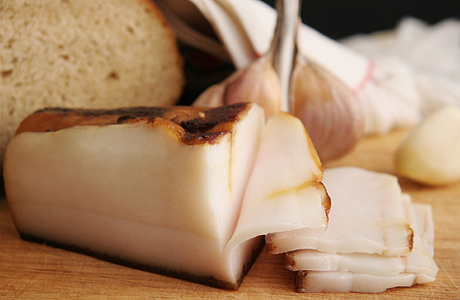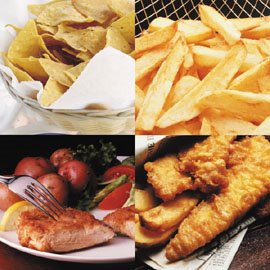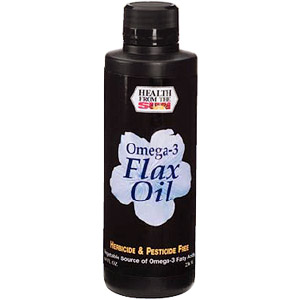
Fat
Fat- one source of energy and important in relation to fat soluble vitamins.
There are two main types of fat depending on an origin: animal fat (sources: meat, fish, cheese, butter, milk) and vegetable fat (sources: avocado, canola oil, nuts like almonds, cashews, pecans, and peanuts, olive oil and olives, peanut butter and peanut oil). Depending on a chemical formula fat subdivided into three groups: saturated fat, unsaturated fat and trans fat.
Saturated fat

Everyone should eat less saturated fat. Doctors believe that people who eat saturated fat diets increase their risk of developing life-threatening cholesterol deposits in the lining of their arteries.
Sources:
- High-fat dairy products such as full-fat cheese, cream, ice cream, whole milk, 2% milk and sour cream.
- High-fat meats like regular ground beef, bologna, hot dogs, sausage, bacon and spareribs
- Lard
- Butter
- Fatback and salt pork
- Cream sauces
- Gravy made with meat drippings
- Chocolate
- Palm oil and palm kernel oil
- Coconut and coconut oil
- Poultry (chicken and turkey) skin
- Cream
Try to eat less than 10% of your total calories as saturated fat. For most people this means less than 20 grams of saturated fat per day. For people with high cholesterol, this is less than 15 grams of saturated fat per day. Many adults, especially women or sedentary men, may need less.
Trans fat

Trans fats are produced when liquid oil is made into a solid fat. This process is called hydrogenation. Trans fats act like saturated fats and can raise your cholesterol level. Sources of trans fat include:
- Processed foods like snacks (crackers and chips) and baked goods (muffins, cookies and cakes) with hydrogenated oil or partially hydrogenated oil
- Stick margarines
- Shortening
- Some fast food items such as french fries.
Unsaturated fat
Unsaturated fat subdivided into two groups: monounsaturated fat and polyunsaturated fat. These fats, basically, are liquid in the room temperature, but some of them are solid (e.g. margarine).
Monosaturated fat

Monounsaturated fats are called "good or healthy" fats because they can lower your bad (LDL) cholesterol.
Sources:
- Avocado
- Canola oil
- Nuts like almonds, cashews, pecans, and peanuts
- Olive oil and olives
- Peanut butter and peanut oil
- Sesame seeds
ADA recommends eating more monounsaturated fats than saturated or trans fats in your diet. To include more monounsaturated fats, try to substitute olive or canola oil instead of butter, margarine or shortening when cooking. Sprinkling a few nuts or sesame seeds on a salad is an easy way to eat more monounsaturated fats. But be careful! Nuts and oils are high in calories, like all fats. If you are trying to lose or maintain your weight, you want to eat small portions of these foods. For example, 6 almonds or 4 pecan halves have the same number of calories as 1 teaspoon of oil or butter. Work with your dietitian to include healthy fats into your meal plan without increasing your total calories.
Polyunsaturated fat

Polyunsaturated fats are also "healthy" fats. ADA recommends that you include these in your diet as well as monounsaturated fats.
Sources:
- Corn oil
- Cottonseed oil
- Safflower oil
- Soybean oil
- Sunflower oil
- Walnuts
- Pumpkin or sunflower seeds
- Soft (tub) margarine
- Mayonnaise
- Salad dressings
- Flax oil.
Although fats have received a bad reputation for causing weight gain, some fat is essential for survival. According to the Dietary Reference Intakes published by the USDA 20% - 35% of calories should come from fat. We need this amount of fat for:
- Energy (fat is the most concentrated source of energy)
- Absorbing certain vitamins ( like vitamins A, D, E, K, and carotenoids)
- Normal growth and development
- Providing cushioning for the organs
- Maintaining cell membranes
- Providing taste, consistency, and stability to foods
Experts do not agree about the ideal level of dietary fat and, in fact, there may not be just one ideal level. A reasonable goal for most people would be to have saturated fat pro-viding no more than 8-10% of calories and a total fat intake between 15 and 30% of total calories. Fat intakes at the higher end of this range, when the fat is monounsaturated fat (nuts, seeds, olive oil, canola oil, avocado), may be a better choice than restriction of all types of dietary fat. In practical terms, what does 30% or less of calories from fat mean?
| Daily calories: | Your fat intake should be no more than: | Your saturated fat intake should be no more than: |
| 1600 | 53 grams | 17 grams |
| 2000 | 66 grams | 22 grams |
| 2200 | 73 grams | 24 grams |
